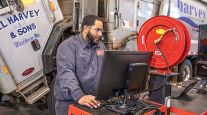Some Fleets Postpone Preventive Maintenance as Economics Override Weather Conditions
By Timothy Cama, Staff Reporter
This story appears in the Dec. 6 print edition of Transport Topics.
When the economy deteriorates, the use of preventive maintenance at trucking companies — including programs involving tires — sometimes follows suit, regardless of climate conditions such as the coming of winter.
“The economic challenges faced by all carriers may have caused some to get off their normal preventive maintenance program,” said John Hausladen, president of the Minnesota Trucking Association.
Because Minnesota is in the country’s snow belt, it usually gets more than its share of all types of troublesome precipitation, hard-blowing winds, low temperatures and poor road conditions and visibility.
“This is certainly the time to get back on schedule if you’ve gotten off-track,” Hausladen said.
Tire-replacement and other trucking company maintenance schedules, however, seem to continue to ignore seasonal weather when economic times are troubling.
But companies such as UPS Inc. don’t abandon their programs when times are tough. David Zack, the Atlanta-based company’s director of maintenance and engineering, said that no matter the season, the company usually replaces its trucks’ tires when they reach the Department of Transportation’s minimum tread depth — 4/32 of an inch on steer tires and 2/32 on drive tires.
Some “overzealous” maintenance teams may replace tires before they reach the DOT minimums to allow for better traction in bad weather, he said.
As for chains, UPS only uses them when states require it, Zack said. Many states tell truckers to use chains during certain storms.
“When you get out to the Rockies, they’ll put some chains on just to get around,” he said. But when the state doesn’t require it, “a lot of our drivers are okay with not using them,” Zack said.
“You go up to Chicago, none of those guys up there need chains,” he said. “Then you go down to Baltimore and they all want chains.”
Tim Miller, marketing communications manager for commercial tires at Goodyear Tire & Rubber Co., Akron, Ohio, said that despite the deterioration of road conditions during the winter, carriers rarely use different tires. He said Goodyear used to sell commercial tires designed for winter driving, but it has since discontinued those lines.
“I don’t think they were a huge success,” Miller said.
Goodyear started making the tires after its Canadian unit requested them, Miller said, adding that they were sold almost exclusively to Canadian customers.
“It’s probably more of a pain for the fleet to switch out tires and switch them back in the spring,” he theorized.
Yokohama Tire Corp., Fullerton, Calif., agrees with that assessment — up to a point.
“Tire maintenance is an ongoing process and fleets that make the investment and allocate sufficient resources towards tire maintenance will definitely see a return on that investment in the bottom line,” Rick Phillips, Yokohama’s manager of commercial sales, said in an e-mail. “This includes clearly defined replacement parameters, regularly scheduled inspections and then actually following through and replacing tires as needed.”
Phillips said he has noticed “a noticeable spike in drive tire purchases usually toward the end of summer.” However, he said his company encourages its customers “to match right the tire to a particular application.”
“Winter weather definitely presents challenges for tires, especially regarding traction,” he said. “Advances in technology have greatly improved tire performance in inclement weather.”
Phillips said Yokohama’s Z.environment technology helps manage the tire’s contact patch as it rolls through the footprint.
“This more consistent footprint translates to better traction due to less friction energy or slippage,” he said.
Goodyear’s Miller recommends that fleets using normal tires in the winter keep a close eye on inflation pressure and consider replacing tires earlier than they might otherwise plan.
Since air contracts when it gets cold, tires lose pressure in lower temperatures. Goodyear tells its customers to inflate tires by one additional PSI for each 10-degree drop in temperature, Miller said.
“We encourage people to check their tires and make sure they’re inflated for the load that’s being carried,” he said.
If a fleet knows it has to get new tires soon, Miller recommends installing the tires before the winter. This gives fleets extra tread depth for the poor road conditions.
“If you feel that you’re close to needing new tires in the near future anyway, or you just plain need tires,” he said, “now’s the time to tire up and put the freshest thing you have on there.
“Certainly your best traction capability is with a new tire,” he added.
In especially bad climates and snow, trucks could use tires designed for a single drive axle truck on their tandem drive axle trucks in the winter, Miller said.
The Goodyear manager said he has seen some fleets put sipes on their tires after they buy them. Siping involves cutting small slices, or sipes, across the tread of a tire to improve traction.
Typically, fleets in the Pacific Northwest put sipes on their tires, Miller said, adding that he hasn’t seen it become popular anywhere else.
Fleets that operate in the Pacific Northwest “claim that [siping] really helps winter traction,” he said.
Goodyear does not condone or condemn siping, and Miller warns that siping might void some parts of a tire’s warranty. Tire dealers usually make the sipes after the customer buys the tire.
And tire replacement isn’t the only maintenance procedure that defies seasonal considerations.
Take Pitt Ohio Express, Pittsburgh, for instance. The regional less-than-truckload company that ranks No. 72 on the Transport Topics Top 100 For-Hire Carriers in the United States and Canada list, decided years ago to do away with its seasonal maintenance schedule, said Denny Martin, director of maintenance.
“We’ve gotten away from any seasonal fluctuations on our maintenance and really focused on maintaining the same standards throughout the year,” Martin said.
Pitt Ohio used to have a maintenance schedule that focused on seasonal needs.
“It really got us in trouble, especially with equipment that doesn’t always get into the shop for maintenance,” Martin said. “And then you neglect it.”
For example, maintenance staff used to check air conditioning only in the summer. But that increased the chances that a truck might miss the seasonal maintenance inspection, leaving the air conditioning subject to malfunction from neglect. Now, Martin said, Pitt Ohio’s maintenance checks cover the entire truck for everything the vehicle will need during the entire year.
Celadon Group, Indianapolis, only slightly changes its maintenance practices for the winter, according to President Paul Will. The truckload carrier, which ranks No. 42 on the TT 100 for-hire list, runs routes that reach into Canada.
Celadon uses separate heaters in truck cabs to reduce the need for drivers to idle, he said. It also uses additives in diesel fuel.
“We’ve got higher-amp batteries that we run to help during the winter months,” Will said; the same batteries stay in the trucks year-round.
Celadon and Pitt Ohio have both felt pressure from the economic downturn, but neither has made significant cuts to maintenance, representatives said.
Celadon has extended the time between oil changes, Will said.
As for Pitt Ohio, the company said the economy has forced it to keep its old trucks longer than it would like — and that has increased the focus on maintenance.
“We realized early on that if we’re going to maintain older equipment longer, it’s going to take a little more to maintain it,” said Martin.
Despite the move away from seasonal truck upkeep, most manufacturers and industry organizations still encourage trucking companies to provide climate-related maintenance.
Navistar International Corp., Warrenville, Ill., however, does not. It offers a maintenance information guide for on-highway applications that provides a section on “Service Intervals & Operations.” This section links maintenance schedules to miles traveled as opposed to seasonal considerations.
“For the most part, there are so many different variables involved when dealing with the weather — and a lot of that depends on how people operate” their vehicles, said Brian Mulshine, Navistar’s manager of service development and education.
Mulshine said that most of his company’s customers are already aware of how to handle cold-weather problems such as using a different blend of oil; keeping track of coolant levels and integrity; and checking the crank case filter to make sure the crank case is receiving the proper amount of air.
The guide also includes a section that stresses careful attention be paid to dashboard warning lights to alleviate trouble with diesel particulate filters; high exhaust system temperature; and the stop alert lamp, which indicates a serious problem has occurred that will require a service call.
Kenworth Truck Co., Kirkland, Wash., on the other hand, distributes a list of “winterizing” tips — a set of preventive maintenance measures it asks its customers to complete before winter weather sets in.
Most of the tips, however, are good for maintenance in all seasons. Kenworth recommends change fuel filters, for example, and ensuring that there is no water or oil in air tanks.
American Trucking Associations’ Technology & Maintenance Council publishes “Cold Weather Operation,” a guide that serves as a good starting point for fleets’ winter maintenance, said Robert Braswell, TMC’s technical director.
The guide, one of TMC’s “Recommended Practice” papers, covers a variety of issues related to winter truck maintenance. It includes instructions for checking engine coolant, batteries, fuel, air brakes, air intake and other parts of a truck that have special maintenance needs in the winter.




